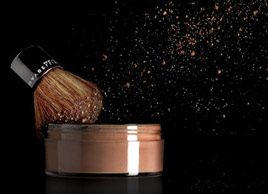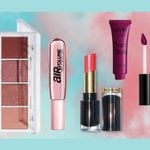Mineral makeup 101
Mineral makeup is taking the beauty world by storm. But beyond all the buzz, is it better than conventional makeup? We’ve done the homework for you

Source: Best Health Magazine, October 2008; photo by Christopher Stevenson
What is mineral makeup?
Mineral makeup is the cosmetic world’s answer to the green movement. Its main components are naturally occurring or mined materials from the earth, such as titanium dioxide (a natural sunscreen), zinc oxide (a natural anti-inflammatory) and iron oxides. These minerals are finely ground and purified before going into the products you find in stores, says cosmetic scientist Marie Bertrand of SkinScience Inc., a Calgary-based company that specializes in the study of active ingredients, skincare formulations and their application on skin.
While the category has seen an avalanche of growth over the past few years (in 2005, 132 mineral-based cosmetics were introduced; in 2007, that number had jumped to 451), not all mineral makeup lines are created equal. According to Dr. Hema Sundaram, a Washington, D.C., dermatologist and the author of the 2003 book Face Value: The Truth About Beauty—and a Guilt-Free Guide to Finding It, the best mineral brands are free of fragrances, preservatives and chemicals that conventional makeup contains.
What qualifies as “mineral”?
There are no set regulations from Health Canada or the U.S. Food and Drug Administration on what constitutes mineral makeup, says Bertrand, which means that any product containing mineral powders as a main ingredient can be labelled as such. To find the purest product, she says, look for ones that don’t contain chemicals such as bismuth oxychloride (a commonly found by-product of lead refining that’s thought to cause acne and micro tears in skin) and added colours, binders and preservatives.
How is mineral makeup different?
Beyond the ingredients, there are a few other differences compared to conventional makeup:
- Your choices of mineral makeup can be limited. For example, the different formulations you’d find with conventional foundations (liquid, cream, tinted moisturizer, cream-to-powder, liquid-to-powder, etc.) may not be available in mineral form. But choices are increasing: Maybelline and Physicians Formula, for example, have mineral liquid foundations.
- Loose mineral powder—still the most popular form of mineral makeup—offers three to five percent coverage, compared with conventional liquid foundations (and some conventional compact powder foundations), which can vary from 10 to 40 percent per application for regular and high-coverage products. If you want to wear mineral makeup foundation but are looking for higher coverage, choose liquids, which can offer light, medium and high coverage.
- Because it contains titanium dioxide and zinc oxide, mineral makeup offers some natural sun protection. That said, it doesn’t replace the need for a sunscreen or block when you’re going to be exposed to the sun.
Why you might like it…
Besides doing your skin a favour by limiting its exposure to the chemicals and preservatives found in many conventional cosmetics, the advantages are plentiful. Most people can use it because it’s not irritating, says Roseanne Fama, L’Oréal Paris’s vice-president of product development, but it’s an especially good choice for those with sensitive or reactive skin since it usually contains fewer additives. Mineral makeup is also waterproof and photo-stable (meaning it won’t degrade because of sun exposure), offers a smooth finish, absorbs excess oil, and is economical because a little goes a long way. Another benefit: Titanium dioxide and zinc oxide have anti-inflammatory properties and can have a calming and soothing effect on skin, especially in mild to moderate cases of acne, rosacea, psoriasis and eczema.
To look as fresh-faced as possible, apply mineral powder in light layers, Bertrand says. “Applying too much can leave a cakey, mask-like look, so use a little bit of product at a time and buff in circular motions.” To find your perfect shade, she says, test the colour on your jawline, starting with a light application and adding more if necessary.
…and why you might not
Mineral makeup looks best on a good canvas. “If the skin is dry and lacking in natural oils,” says Bertrand, “this type of makeup can feel dry since it has a tendency to absorb oil, and skin may look parched.” To prevent this, properly hydrate your skin with day and night creams. Also, consider that mineral makeup isn’t designed to conceal skin conditions or issues such as vitiligo, dark pigmentation, bruising or birthmarks.
Don’t miss out! Sign up for our free weekly newslettersand get nutritious recipes, healthy weight-loss tips, easy ways to stayin shape and all the health news you need, delivered straight to yourinbox.




